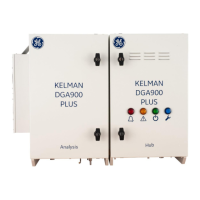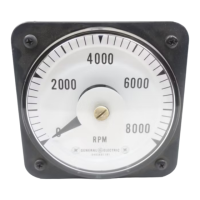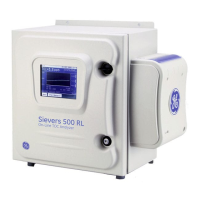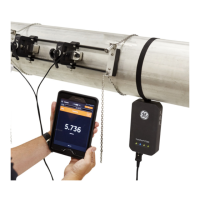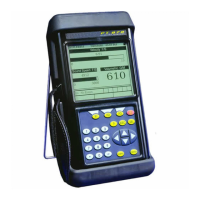Krautkramer USM 35X Issue 01, 04/2005 5-23
OperationCalibrating the USM 35X
– Press to record the second calibration echo.
The correct calibration is confirmed by the message
“Calibration is done”. The material velocity and
probe delay are set. The value of the CAL function
goes back to 0.
– If necessary, check the calibration on one or several
known calibration lines, e.g. using the stepped
reference block VW.
H Note:
Always keep in mind that the measured value is deter-
mined at the intersection point of gate and echo flank
when the function TOF was set to flank. A correct set-
ting of the echo height and gate threshold is therefore
decisive for accurate calibration and measurement!
Calibrations or measurements in the peak mode are
mostly not possible when using dual-element (TR)
probes. As the echoes are often very broad and jagged,
a clear echo peak cannot always be found in these
cases.
5.8 Measuring
General notes
Please pay attention to the following notes when mea-
suring with the USM 35X.
• Condition for measurements is the correct instrument
calibration (sound velocity, probe delay).
• All amplitude measurements are carried out at the
highest or the first signal in the gate.
• All distance measurements are carried out at the
intersection point of gate and the first echo flank
(TOF = flank or jflank), or at the peak of the highest
echo (TOF = peak).
• If the echo amplitudes do not succeed 5 % screen
height all sound path and amplitude measurements
will be suppressed. Thus, rapidly changing random
measurements caused by the instrument’s back-
ground noise are avoided.
Krautkramer USM 35X Issue 01, 04/2005 5-23
OperationCalibrating the USM 35X
– Press to record the second calibration echo.
The correct calibration is confirmed by the message
“Calibration is done”. The material velocity and
probe delay are set. The value of the CAL function
goes back to 0.
– If necessary, check the calibration on one or several
known calibration lines, e.g. using the stepped
reference block VW.
H Note:
Always keep in mind that the measured value is deter-
mined at the intersection point of gate and echo flank
when the function TOF was set to flank. A correct set-
ting of the echo height and gate threshold is therefore
decisive for accurate calibration and measurement!
Calibrations or measurements in the peak mode are
mostly not possible when using dual-element (TR)
probes. As the echoes are often very broad and jagged,
a clear echo peak cannot always be found in these
cases.
5.8 Measuring
General notes
Please pay attention to the following notes when mea-
suring with the USM 35X.
• Condition for measurements is the correct instrument
calibration (sound velocity, probe delay).
• All amplitude measurements are carried out at the
highest or the first signal in the gate.
• All distance measurements are carried out at the
intersection point of gate and the first echo flank
(TOF = flank or jflank), or at the peak of the highest
echo (TOF = peak).
• If the echo amplitudes do not succeed 5 % screen
height all sound path and amplitude measurements
will be suppressed. Thus, rapidly changing random
measurements caused by the instrument’s back-
ground noise are avoided.
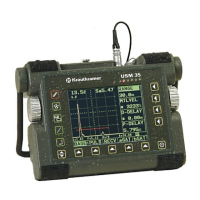
